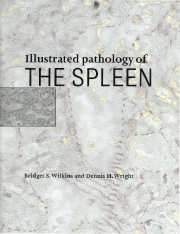Book contents
- Frontmatter
- Contents
- Preface
- Acknowledgements
- 1 Introduction
- 2 Normal structure, development and functions of the spleen
- 3 Post-traumatic and incidentally removed spleens
- 4 The spleen in hereditary blood cell abnormalities and auto-immune disorders
- 5 The spleen in immunodeficiency and systemic infections
- 6 Lymphomas involving the spleen
- 7 The spleen in myeloproliferative disorders
- 8 Pathology of the splenic stroma
- 9 Metastases and miscellaneous conditions
- 10 Summary: some key points in splenic differential diagnosis
- Index
8 - Pathology of the splenic stroma
Published online by Cambridge University Press: 14 August 2009
- Frontmatter
- Contents
- Preface
- Acknowledgements
- 1 Introduction
- 2 Normal structure, development and functions of the spleen
- 3 Post-traumatic and incidentally removed spleens
- 4 The spleen in hereditary blood cell abnormalities and auto-immune disorders
- 5 The spleen in immunodeficiency and systemic infections
- 6 Lymphomas involving the spleen
- 7 The spleen in myeloproliferative disorders
- 8 Pathology of the splenic stroma
- 9 Metastases and miscellaneous conditions
- 10 Summary: some key points in splenic differential diagnosis
- Index
Summary
Splenic granulomas
‘Incidental’ granulomas
Small oleogranulomas, usually located at the interface between red and white pulp, are very common incidental findings in the spleen (Fig. 8.1). Their origin is uncertain; dietary exposure to mineral oils has been suggested, or previous radiographic investigations employing lipid-based contrast media. These granulomas are of no clinical significance but they should be recognized in order to distinguish them from other, potentially important forms of granuloma and granuloma-like lesions which may occur in the spleen.
Small epithelioid granulomas may also be found incidentally. They were seen frequently in spleens removed during laparotomies performed for staging of Hodgkin's disease (HD); see Chapter 6 and Chapter 10. With the advent of computerized tomography, staging laparotomy rapidly became obsolete during the mid-1980s but unexplained, usually epithelioid, granulomas are still found in spleens removed for a wide variety of reasons.
Significant granulomatous inflammation in the spleen
On occasions, the spleen may be massively infiltrated by sarcoid-like or caseating granulomas; sarcoidosis or mycobacterial infection should be investigated in such cases as the obvious likely causes. Extensive sarcoid-like reaction, however, can be seen occasionally as an apparently isolated phenomenon, in the absence of any confirmatory evidence of true sarcoidosis. We have seen two patients with splenomegaly due to massive infiltration by sarcoid-like granulomas accompanied by hypogammaglobulinaemia, suggesting altered immune responsiveness to a pathogen (or other antigen) as a cause for the granulomatous response.
Tuberculosis and M. avium-intracellulare infection involving the spleen have been described in Chapter 5.
- Type
- Chapter
- Information
- Illustrated Pathology of the Spleen , pp. 125 - 150Publisher: Cambridge University PressPrint publication year: 2000
- 3
- Cited by



